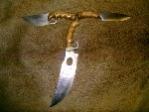Found this plant while out checking our flags and making notes in our journals. At first it looked like Asclepias syriaca, but on closer inspection, the leaves were not at right angles to one another, nor did they taper to a rounded end. These were all along the same plane, and the plant grew horizontally. It was rooted in a bank off the trailside, which might explain it's horizontal growth, rather than erect.
Perhaps it is a different species?
Guests can not see images in the messages. Please register in the forum.
Guests can not see images in the messages. Please register in the forum.
There were no flowers on it. Hope to go back this weekend and check it again. We flagged it and plotted the location in our journals for study.







 Reply With Quote
Reply With Quote



 It is good exercise!
It is good exercise!


Bookmarks